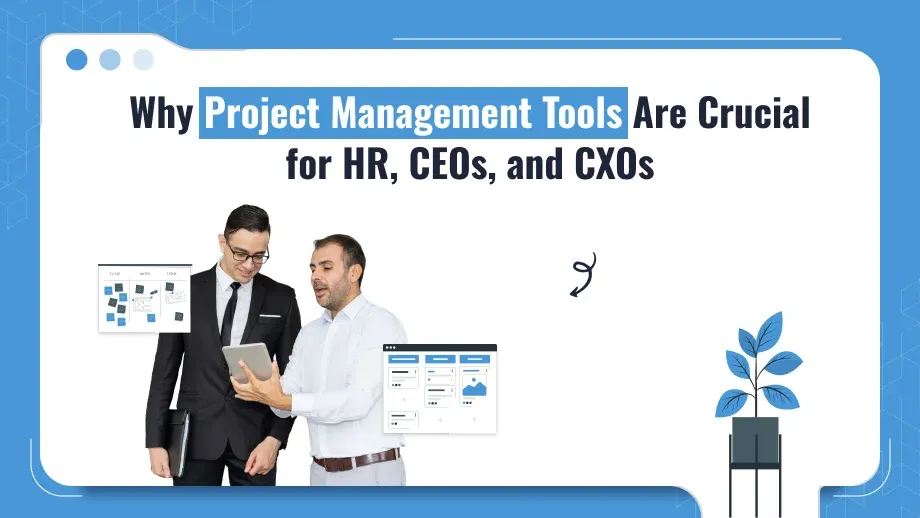
In the current business climate, which is fast-paced, it is essential to effectively manage projects vital for companies to stay in the game and meet their goals. For HR executives or CXOs, CEOs, and other executives choosing the best tools for managing projects goes far beyond simple project management tools. It’s about aligning groups, automating processes and taking data-driven, informed decisions to propel the organization forward.
Project management tools can assist executives have a clear understanding of the ongoing projects making sure that resources are distributed effectively, deadlines are adhered to and risk is minimized. In HR These tools can streamline tasks such as the delegation of tasks, monitoring performance and collaboration among teams. For CXOs and CEOs they can provide live analytics in real-time analytics and an eagle’s-eye overview of every project and help them guide the business towards its goals.
If you’re trying to enhance the collaboration between different departments, streamline administration tasks, or just keep your organization in order, selecting the appropriate project management tools could significantly influence your employees’ productivity as well as the general success of your company. In this piece we’ll look at the most important features you should look out for in your project management software, look at popular platforms such as Asana Monday, Asana as well as Super Project, and explain the ways these programs can meet the specific needs of HR managers, CEOs and CXOs.
Why Project Management Tools Matter for HR, CEOs, and CXOs
for HR specialists executives, CXOs, and CEOs The success of the company is heavily dependent on how effectively projects are run. For these jobs the focus isn’t just on monitoring tasks; it’s about making decisions that are strategic, maintaining that teams are efficient, and coordinating the day-to-day activities with longer-term objectives of the business. The Project management tools can help leaders accomplish these goals through tools that increase efficiency, transparency, and collaboration. making decisions.
HR’s Perspective
for HR specialists, these project management tools can help to monitor employee work load and assess performance among different departments and teams. HR professionals need to be aware of the people who are working on which tasks and how they are going. Software such as Asana and Monday.com allow real-time tracking of tasks and help HR managers make sure that workloads are evenly distributed and that employee performance is in line to the larger goals of the company.
Furthermore the tools can aid HR to handle projects for onboarding and training. For instance, HR departments may use project templates to help new employees onboard as well as track their progress in training and oversee employee engagement efforts. Instruments such as Super Project that integrate with HR systems enable seamless administration of human resources as well as project management from one central location increasing overall productivity as well as decreasing the administrative load.
CEO and CXO’s Perspective
for CXOs and CEOs alike Tools for managing projects help in assessing the overall perspective. They have to manage several projects in different departments to ensure that resources are effectively allocated and that the teams have a clear focus on the firm’s objectives. Tools for managing projects that have advanced reports, like Asana and Super Project, offer high-level insight into the project’s progress resources used, as well as possible dangers.
Through features such as automation and live dashboards, CEOs and CXOs are able to cut down in manual monitoring and concentrate more on strategic decisions. Instruments such as Jira and Monday.com are also able to support agile methods which allow companies to remain flexible and adaptable to changes in the market.
The alignment of projects with the business strategy
One of the biggest problems for the leader is making sure that projects follow the long-term goals of the business. Instruments such as Super Project allow leaders to define project objectives which directly connect with strategic business objectives. Through the use of integrated dashboards for performance leaders can effortlessly monitor the extent to which ongoing projects are contributing to general business objectives and can take necessary adjustments as required.
For CXOs who are focused on experience, operations, or technology, these tools give transparency across departments and allow better coordination and align. By utilising features such as budget and resource management CXOs are able to ensure each project will be able to achieve its goals, and not exceed budget limits.
Why Project Management Tools Are Essential for Leadership
The selection of the appropriate tools for managing projects is essential to maximize efficiency while aligning the project with objectives of the business. The following are some of the essential aspects that management teams must consider when choosing a tools for managing projects:
1. Automation and Workflow Management
The most effective project management tools automates routine tasks like assigning tasks that are recurring as well as sending notification emails or resetting task statuses. The result is a reduction in the manual workload on teams, allowing their time to concentrate on more valuable jobs. Software such as Asana and Monday provide automatization features that simplify project workflows and ensure that deadlines are met with no constant monitoring.
Automation also facilitates smoother transfers between team members and departments, allowing it to be easier to oversee complex projects among multiple departments. If a company is handling several simultaneous projects, these workflows that are automated will ensure that nothing gets lost in the gap.
2. Real-Time Collaboration
In today’s hybrid and remote workplaces, real-time collaboration is crucial. The tools for managing projects must offer integrated communication tools like group chats, comments about the tasks and the sharing of files, which facilitates collaboration, without the necessity of additional tools. Platforms such as ClickUp as well as Super Project integrate real-time collaboration tools that ensure groups are on the same page and connect directly with each other through the platform.
It also decreases dependence on email or other app-based messaging services from other parties, while keeping documents and communications related to projects all in one place. The leadership team can keep track of conversations and make decisions that are related to particular tasks or deadlines.
3. Scalability and Customization
With the growth of businesses, requirements for managing projects become more complicated. Choose tools that allow flexibility, regardless of whether you are either a small or large corporation. Applications such as Super Project allow companies to manage large-scale projects with ease with no impact on project or user limitations. It is possible to tailor the dashboards and workflows are vital, which allows businesses to customize the software for their particular processes.
In particular, dashboards that can be personalized offer CXOs and CEOs with clear and concise information about project development and utilization of resources. Tools such as Trello provide boards with customizable layouts which help you visualize the stages of a project and more sophisticated tools such as Asana permit the customization of workflows to meet particular operational requirements.
4. Advanced Reporting and Analytics
The leadership teams depend on the data-driven information they receive for making informed decisions on the timeline for projects, allocation of resources as well as the overall strategy of business. Tools for managing projects like Super Project and Jira offer advanced reporting features, which enable managers to create specific reports on the most important metrics of performance (KPIs) like timeliness of the project, hours spent as well as budget monitoring.
These tools can help leaders to identify the bottlenecks in their teams, assess team efficiency, and determine whether their projects align with their strategic objectives. In-depth analytics provide instant information on how the projects are doing, which is essential for CEOs and CXOs that need to evaluate the effects of initiatives on the company’s growth.
5. Integration with Other Business Tools
The tools for project management should easily integrate with other vital enterprise platforms like payroll systems, HRMS, payroll systems, CRM, and communication tools. The integration let’s data move between different platforms without the need for manual input, which reduces errors and enhances the overall effectiveness. As an example, Super Project offers integration with Super HRMS and other business-critical tools to ensure that every aspect of your business are linked.
Integration with different software means that data is transferred across different departments, which allows to improve coordination and collaboration. This is particularly important for leaders who manage multi-functional projects.
6. Security and Compliance
If you are a company handling sensitive information Security is a must. Tools for managing projects must provide high-level security options like encryption, two-factor authentication and access control based on role. This ensures that confidential data about projects is protected regardless of whether it is shared between several departments or with external parties.
Instruments such as Asana & Super Project include high-quality security and compliance options that are compliant with data protection rules, allowing them to be used for sectors such as healthcare, finance or legal.
Manage Projects with Ease – Use the Right Tools for Success!
Streamline your team’s tasks and hit deadlines faster. Get started with our project management tools now!
Top Project Management Tools for Leadership Teams
After we’ve discussed the key features you should seek out in the tools for managing projects now it’s time for a look at the most popular platforms. Every tool is unique in its own way that meet different requirements such as ease of use, sophisticated reporting and seamless integration other company tools.
1. Super Recruit – Best for Streamlining Recruitment Processes
Super Recruit stands out for the ability it has to streamline the recruitment process for companies regardless of size. It offers an extensive platform for connecting the hiring team, the candidates and the hiring objectives. Through its user-friendly interface, Super Recruit provides features like applicant tracking, automated schedules for interviews, as well as immediate reporting for better the efficiency of hiring. Super Recruit is highly flexible, and integrates seamlessly with other popular HR software such as Workday, BambooHR, and Slack.
Key Features:
- Automated management of candidates and schedule of interviews.
- Flexible hiring workflows that can be customized to suit every recruitment procedure.
- Integration of HR software with the most popular to make hiring easier.
- Advanced security tools to guard the data of candidates.
2. Asana – Best for Enterprise-Level Project Management
Asana is well-known for its capability to assist large companies with tools for work management solutions that link groups, teams and goals for strategic purposes throughout the business. It provides a range of tools, like tasks automation, templates for projects and sophisticated dashboards for reporting which provide transparency across all project. It is highly customizable and can be integrated with an array of different business tools like Slack, Microsoft Teams, and Salesforce.
Key Features:
- Modern task automation, as well as live project tracking in real time.
- Templates and workflows that can be customised.
- Integration with over 100 different business tools.
- Complete security and compliance options.
3. Trello – Best for Simple and Visual Project Management
Trello utilizes a Kanban-style board for teams to organize their work visually. It is a great choice for small teams or groups that require a simple solution. Trello can be a simple tool to implement and works well for teams that want to handle small, focused projects that don’t require any complexity. But, its simple interface could limit the use of Trello for bigger project that are more complex.
Key Features:
- A simple, user-friendly interface that works with Kanban boards.
- It is ideal for visualizing projects and the stages of a project.
- Simple to integrate into apps including Slack or Google Drive.
- Limits in scaling to larger teams.
4. Monday – Best for Small to Mid-Sized Teams
Monday.com is a flexible project management tool. It offers customizable workflows. This makes it ideal for small-sized businesses and teams growing. It has a simple interface that allows teams to swiftly begin managing projects using minimal set-up. As businesses grow it can be limited in its capabilities.
Key Features:
- Dashboards and templates that can be customized.
- Simple onboarding, quick set-up for teams of a smaller size.
- Automatization features can make manual work easier.
- Scalability limited to large-scale enterprises.
5. Jira – Best for Agile Project Management
Jira is owned by Atlassian It is designed to facilitate Agile project management. It is the most used software for teams working on development. It offers features such as backlog management, sprint planning and issue tracking. This makes the ideal tool for teams that adhere to Agile or Scrum methods. Jira is extremely customizable and can be integrated with other Atlassian tools such as Confluence.
Key Features:
- Most suitable, best suited for Agile teams equipped with integrated toolkits for planning sprints.
- A detailed issue tracking system to help development teams.
- Advanced performance reporting and analytics.
- In-depth integration to different Atlassian products.
6. Super Project – Best for Comprehensive Business Integration
Super Project offers a robust software for managing projects. It is built to work with other critical tools for business like Super HRMS and Super Chat and provide a seamless user experience for all different departments. Super Project caters to teams of leaders seeking a system that can deal with complex cross-functional and multi-disciplinary projects, with sophisticated reporting and specific workflows. Super Project is also scalable and is ideal for companies that are growing and require the most precise tracking as well as high-level analysis.
Key Features:
- Easy integration to payroll, HR as well as communication tools.
- Modern resource management, as well as real-time collaboration.
- Flexible reporting to monitor key performance indicators for projects.
- High-end security and compliance for enterprises.
Each of these tools offers unique advantages depending on your company’s needs. For leadership teams seeking to manage both high-level strategy and day-to-day tasks, Super Project stands out for its ability to integrate with other critical systems and provide actionable insights through customizable reporting. Tools like Asana and Jira are excellent for large enterprises and Agile teams, while Trello and Monday.com are better suited for simpler or smaller projects.
Benefits of Using Project Management Tools for Leadership
Tools for managing projects have advanced beyond task trackers that are simple and have become essential for leaders teams. They offer a variety of advantages that increase efficiency, collaboration, and alignment with strategic goals. for HR professionals, CEOs and CXOs, these tools offer instantaneous insights, enhance the allocation of resources, and facilitate an informed decision-making process based on data.
1. Improved Cross-Department Collaboration
If you have several departments that are working on connected projects, the tools for managing projects serve as a central point of contact where the teams of all departments can work together and keep their focus on the same goal. Software like Asana or Super Project facilitate cross-functional collaboration through shared workspaces in which teams are able to communicate with each other, share documents, and keep track of tasks in real time.
It ensures that everyone from HR to the top executives are kept informed of progress of the project and can work effortlessly across different departments. In terms of leadership, this results in less miscommunications, greater transparency and more align with the strategic direction.
2. Data-Driven Decision-Making
One of the greatest benefits to leadership teams is their ability to take informed decisions based on real-time data and data offered by tools for managing projects. Software like Jira as well as Super Project offer advanced reporting features that let executives examine project schedules as well as resource utilization and the performance of their teams.
The ability to access this data gives CEOs as well as CXOs to pinpoint the bottlenecks in their teams, evaluate team performance and take informed choices about whether to dedicate more resources or modify the timeline. This kind of information is also invaluable in the quarterly review, meetings with investors and presentations to boards.
3. Enhanced Resource Management
Resource management is a crucial component of leadership. It makes sure that people with the appropriate skills are assigned the correct assignments, and that the tasks are equally distributed. Instruments such as Monday.com or Super Project offer features like work load balancing and resource allocation that help HR departments as well as department head managers make the most efficient use of their staff and the resources.
This is not just a way to improve productivity of the project, it also decreases burnout, as it ensures that nobody is burdened by too many responsibilities. Furthermore, to help CXOs overseeing large teams over several projects, these tools offer a complete review of resource allocation and workload balancing makes it much easier to plan hiring requirements and alter team size based on requirements of projects.
4. Strategic Alignment to Goals of the Business Goals
Leaders must make sure that each project is in line to the larger objectives. Instruments such as Super Project and Asana offer the capability to establish the long-term goal and connect these to ongoing initiatives. This helps managers track how specific initiatives contribute to business expansion and customer satisfaction or operating efficiency.
For CXOs and CEOs The alignment of these two groups ensures that their resources are directed to projects that provide the highest benefits to the business whether that’s improving the customer experience or developing new products or entering new market.
5. Increased Accountability and Transparency
Utilizing tools for managing projects leaders can guarantee the accountability of all employees within the company. Tools such as Trello and ClickUp have tools that allow you for teams to delegate tasks, establish deadlines and monitor performance. It is a way to ensure that everyone is aware of their obligations and will be accountable when deadlines don’t meet.
This also offers an insight into the performance of each employee which helps HR teams identify top performers, as well as individuals who could require further assistance or even education.
By utilizing project management tools, leadership teams can achieve higher levels of efficiency, strategic alignment, and collaboration. Whether you’re looking to streamline operations or gain deeper insights into team performance, these tools are essential for modern organizations.
Challenges in Implementing Project Management Tools
While project management tools offer a wealth of benefits, implementing them across an organization–especially one with complex structures and multiple departments–can present challenges. HR managers, CEOs and CXOs should be aware of the potential issues to ensure a seamless and smooth change.
1. Adoption and Training
One of the biggest problems when it comes to implementing new project management software is getting buy-in from the group. Department heads and employees may be resistant to switching to a new program particularly if they’re used to the traditional approaches like spreadsheets or email to manage the tasks.
The importance of training is to break through this obstacle. Leaders must put their time and effort to make sure that everyone is aware of the software and knows how to effectively use it. Software such as Super Project and Asana provide an easy interface and numerous tutorials However, certain teams may need additional assistance in implementing innovative processes.
2. Integration into Existing Systems
Another issue is making sure that the software for managing projects works seamlessly with the company’s current software infrastructure. For example, organizations which already utilize the HRMS, CRM or financial management software require the project management software that is able to seamlessly transfer data across these systems.
If the software is not integrated with capabilities, it could result in data silos. Teams are forced to transfer data manually between different systems. The tools such as Super Project offer robust integration with business-critical software which can improve workflows and decrease mistakes.
3. Customization for Complex Workflows
Most project management tools come with pre-designed templates and workflows but they may not accommodate the specific needs of each department or even every project. Leaders often require flexible tools that are able to be adapted to a specific company’s procedures. While programs like Trello provide simplicity and ease of use, they do not offer the degree of flexibility required for big complicated projects.
However, platforms such as Jira and Super Project allow for deep customized workflows. However these tools can be more difficult to implement and may need more technical expertise. Teams of leaders may have to face an uphill climb or may need help from experts in order in order to set up the software to work with their processes.
4. Cost Management
Though many of the tools to manage projects provide free versions, or basic plans, the most beneficial functions are usually offered as paid subscriptions. Larger organizations, specifically one with multiple departments or large projects, expanding the application of these tools could be expensive. Leaders must consider the benefits that can be derived from long-term use of the tools for managing projects against annual subscription cost.
These costs could be justified when the tool enhances the efficiency of resources management, as well as strategic align. Software such as Super Project, which offer high-end features, usually cost more however they provide significant value via sophisticated reporting, integration as well as customization.
5. Security and Data Compliance
Data security is a major priority, specifically for those that handle sensitive client information, as well as proprietary information. Tools for managing projects that do not have strong security functions are prone to risks like security breaches and compliance issues. The leadership team must make sure that the chosen tool is in compliance with specific regulations for the industry like GDPR for companies that operate in the European Union or HIPAA for health-related companies.
Software like Asana as well as Super Project provide enterprise-grade security tools, including the ability to encrypt data, control access based on roles as well as compliance with the regulations on data protection which makes them ideal for companies that value data security.
Overcoming these challenges requires careful planning tools and the selection of the right project management tool for the organisation’s specific needs. Leadership teams must be proactive in addressing potential barriers to adoption, ensuring integration, and managing costs effectively.
Conclusion The Ultimate Efficiency, and Strategic Alignment to Project Management Instruments
Tools for managing projects are crucial in modern businesses, especially for leaders who are responsible for managing multiple departments, resources as well as long-term strategic objectives. These tools offer not just task management, they have powerful capabilities such as automation, real-time collaboration and advanced reporting as well as seamless integration with other crucial enterprise systems. Leaders’ teams will benefit from this because it is about making data-driven choices and enhancing cross-departmental collaboration and making sure that every task is in line with larger corporate goals.
There are many advantages of implementing project management software It is important to select the one that best suits your specific business needs. The tools such as Asana, Jira, and Super Project offer robust solutions for big enterprises. They offer flexible workflows, live insight into data, as well as the ability to integrate with other platforms. But, the implementation of these tools may also pose difficulties like team participation as well as cost control and making sure that security is in compliance. Teams in charge of leadership must be ready to spend money on the training process, customized tools and continuous assistance to ensure that they get the most value from these tools.
In the end, choosing the best software for managing projects will transform the way your company operates which will result in improved efficiency and better allocation of resources and a more strategic approach to decision-making at all levels of your enterprise.





